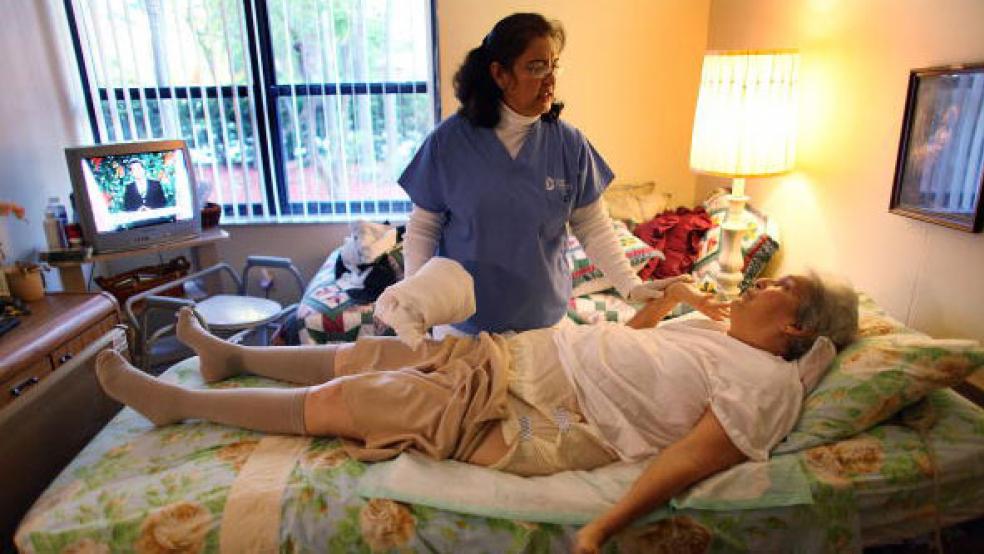If you think Medicare is in bad shape, take a look at Medicaid.
Talk about health care bankrupting the government usually focuses on the senior citizen health care program. Medicare’s hospital trust fund, financed by payroll taxes, will exhaust its reserves by 2017, according to the bean counters at the Center for Medicare and Medicaid Services (CMS).
Physician services and the senior citizen drug benefit are already in the red and require annual infusions of cash from the general treasury. And that includes a major cut in physician pay, triggered whenever compensation grows substantially faster than the rest of the economy — a budget cut slated to go into effect at the end of this month.
But since 2003, Congress has not implemented physician pay cuts, and this year is unlikely to be different. Maintaining doctors’ pay at current levels will require cancellation of a 21 percent cut in Medicare’s physician compensation budget — a fix estimated to cost $210 billion over the next ten years.
Assuming Congress responds as usual to American Medical Association lobbying, Medicare spending on physician services will grow 8.5 to 9 percent over the next five years. Meanwhile, drug spending in Medicare is slated to grow at 11 percent a year. Both will rise more than twice as fast as the rest of the economy and substantially faster than medical inflation as a whole.
Now are you ready for the really bad news? The Medicaid situation is even worse: Unlike the feds, most states, which pick up half the Medicaid tab for the poor, can’t run deficits.
Even if Congress passes health care legislation to expand Medicaid to the working poor (which is financed with tax increases in both bills), Medicaid is slated to experience abnormally high growth rates in the years ahead. According to last week’s projections from CMS, total Medicaid spending will leap 110 percent by 2019 while Medicare will rise "only" 93 percent.
The actuaries’ reasoning was straightforward. A weak economy in the near term will mean more people falling into poverty and qualifying for Medicaid. (One of the ironies of being poor in our society is that a family without any income qualifies for health care coverage in every state in the union, yet a head-of-household who goes out and gets a $10-an-hour job without health insurance in most states does not.)
Even when the economy returns to more normal employment conditions, Medicaid costs will continue to rise at a faster clip than Medicare because more of the poor will be older and nearing retirement, a time when health care costs rise considerably. "Ag[ing] beneficiaries … tend to be more costly than other eligibility groups," a recent report in Health Affairs noted.
The bottom line is that state governors and legislatures will face escalating pressure to raise sales and income taxes to pay for higher Medicaid costs no matter what happens to health care reform. Their only other option is to shortchange schools, roads and all the other services provided at the state level.
No wonder the National Governor’s Association voiced serious qualms last October about piling new obligations for covering the uninsured onto the states. Some of the anger over the "Cornhusker Kickback" to win Sen. Ben Nelson’s vote for the Senate reform bill was a "where’s mine?" cry from other states.
So what can states do?
There has been a lot of skepticism about the Medicare efficiency measures in the reform legislation, which would raise over $400 billion. These measures were used by reform opponents to stir up political angst among seniors, who were told that these efficiencies are cutbacks, not an effort to help Medicare deliver higher quality care.
But there’s been less attention paid to the sections of the reform bills that would encourage state Medicaid programs to experiment with ways of delivering more efficient and effective care. Such experimentation would include establishing care-coordinating medical homes for poor people with multiple chronic conditions, and substituting flat-rate payments for traditional fee-for-service medicine.
States ought to start exploring such approaches in serving their poor, even if reform fails. When it comes to Medicaid, printing money is not an option.
Merrill Goozner is the author of "The $800 Million Pill: The Truth behind the Cost of New Drugs."





